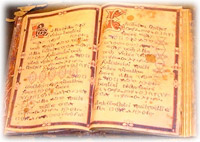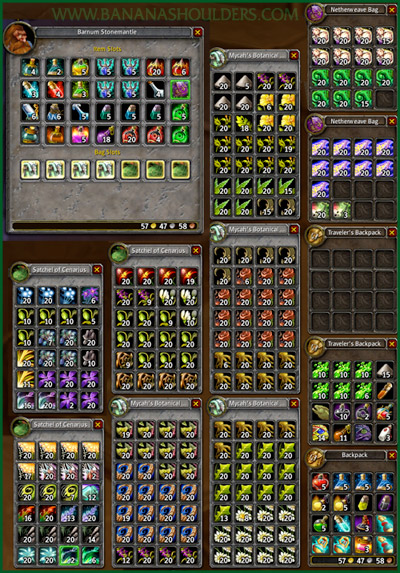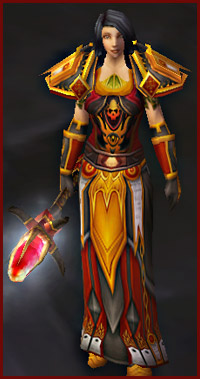Note: this post contains spoilers for Patch 3.0.

This post is a revision of my previous Inscription Guide.
This is the first of a two-part guide to Inscription, the new tradeskill being introduced in Wrath of the Lich King. The second part will cover specific recipes, required mats, and a recommended path for levelling the skill as efficiently and quickly as possible.
Last Update: 10 October; WotLK beta build 9056.
If you have questions, feel free to contact me.
For the full list of Inscription recipes and the complete Inscription Guide, download the guide as a PDF file here: inscription12.pdf. (The full guide is in PDF form because frankly, it’s almost impossible to format all those tables as a blog post.)
Inscription is a profession practised by Scribes. At its core, Inscription involves using herbs to create glyphs of magical power, which enhance spells and items. The profession was originally advertised as new content for the Wrath of the Lich King expansion, but Blizzard have since advised that it will be available as of Patch 3.0 before WotLK is released.
What Scribes Do
Scribes create a number of scrolls, glyphs and other consumables that anyone can use. They make:
In addition, Scribes have several abilities only they can take advantage of:
- Master’s Inscriptions; self-only shoulder enchants (similar to enchanter-only ring enchants or the new tailor-only spellthreads). These come in four varieties: Axe, Crag, Pinnacle and Storm.
- Off-hand items; bind-on-pickup offhands, from low-level blues to level 77 epics.
How Glyphs Work
Every character has a ‘glyphs’ tab in their spellbook, which has slots for 6 glyphs – 3 minor and 3 greater. Glyphs created by Scribes are put in these slots, and will modify the character’s spells. Some glyphs currently require a Lexicon of Power to apply; it’s an in-game item like an alchemy lab or mana loom and there’s one in Dalaran in the Inscription trainer shop.
Minor glyphs give a minor or cosmetic effect, eg:
- changes the visual effect of a spell
- gives a small reduction in a spell’s mana cost
- gives a buff spell increased duration
Major glyphs give a significant upgrade, eg:
- increases chance to avoid interruption while casting
- increases damage done by a spell
Learning Inscription
There are Inscription trainers in various cities of Azeroth, Outland and Northrend:
Neutral
- Professor Palin, Magus Commerce Exchange, Dalaran
Alliance
- Catarina Stanford, near The Stockade, Stormwind
- Elise Brightletter, Great Forge, Ironforge
- Feyden Darkin, Craftsmen’s Terrace, Darnassus
- Thoth, Crystal Halls, The Exodar
- Michael Schwan, Honor Hold, Hellfire Peninsula
- Mindri Dinkles, Valgarde, Howling Fjord
- Tink Brightbolt, Valiance Keep, Borean Tundra
Horde
- Jo’mah, The Drag, Orgrimmar
- Margaux Parchley, The Apothecarium, Undercity
- Poshken Hardbinder, Pools of Vision, Thunder Bluff
- Zantasia, Court of the Sun, Silvermoon City
- Neferatti, Thrallmar, Hellfire Peninsula
- Booker Kells, Vengeance Landing, Howling Fjord
- Adelene Sunlance, Warsong Hold, Borean Tundra
Inscribers will also need an Inking Set and various kinds of blank parchment; these are sold by Inscription Supplies vendors. There’s one in Dalaran, Larana Drome, and other trainers should also be accompanied by them.
Milling
Milling is a subskill of Inscription, and a direct parallel of Jewelcrafting’s Prospecting. Inscribers learn Milling when they first train Inscription skill; it allows an inscriber to turn 5 herbs into raw materials for inks.
These raw materials are called “pigments”; different types of pigments are derived from milling different herbs. The first tier of herbs – Peacebloom, Silverleaf, and Earthroot – produce Alabaster Pigment. Other types of pigment (such as Dusky, Golden, and Emerald Pigment) are milled from higher tiers of herbs.
Milling each batch of herbs also has a chance to produce a rare pigment as well as the common one. For instance, milling 5 Briarthorn will produce 2 or 3 Dusky Pigment, and may also give one or more Verdant Pigments as well.
The rare pigments are used to make rarer inks, which are in turn used to make offhand items, tarot cards and the like. See the upcoming Levelling Guide for more details of recipes.
Milling herbs requires certain Inscription skill levels depending on the level of the herbs. Milling never gives Inscription skill, even at low levels.






 And yet, and yet… only the most hard-hearted players are cruelly efficient enough to be able to delete or vendor everything they’re not actually using at their current level of progression. The rest of us, well – we hold onto our vanity pets and our tabards and our lovely dresses and our festival pantsuits and our armor from three tiers of progression ago that we just can’t bear to get rid of because it looks so cool or we sweated blood getting it.
And yet, and yet… only the most hard-hearted players are cruelly efficient enough to be able to delete or vendor everything they’re not actually using at their current level of progression. The rest of us, well – we hold onto our vanity pets and our tabards and our lovely dresses and our festival pantsuits and our armor from three tiers of progression ago that we just can’t bear to get rid of because it looks so cool or we sweated blood getting it.